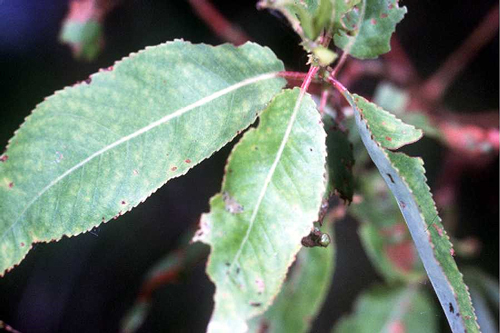The morning is foggy as the boats leave the Grand River. They struggle to pull and row the boats up the Missouri making only eight miles. They meet four traders loaded with furs, and Drouillard hears snakes that gobble like turkeys. Lewis collects specimens of two willow species.
Snakes that Gobble Like Turkeys
by Yellowstone Public Radio[1]Originally aired weekdays by Yellowstone Public Radio during the Bicentennial observance of 2003-2006. Narrated by Hal Hansen. Scripts by Whit Hansen and Ed Jacobson. Produced by Leni Holliman. © … Continue reading
Dangerous Passage
we Set out at 6 oClock, after a thick fog passed thro: a narrow pass . . . . on the L. S. is one of the worst quick or moveing Sand bars which I have Seen not withstanding all our precaustons to Clear the Sands & pass between them (which was the way we were Compd. to pass from the immens Current & falling banks on the S. S.) the Boat Struck the point of one from the active exertions of the men, prevented her turning, if She had turned She must have overset
—William Clark
Four French Fur Traders
a Caussee came too from the Pania [Pawnee] nation loaded with furs We gave them Some whiskey and Tobacco & Settled Some desputes & parted
—William Clarkthey have ben up 3 years with the Indianes 2 of them is half preades of the poncas.
—Charles Floyd
“Cajue (kah-ZHO): A small raft consisting of logs or planks or two canoes lashed together.”[2]Alan H. Hartley, Alan H., Lewis & Clark Lexicon of Discovery (Pullman, WA: WSU Press, 2004), 32.
Gobbling Snakes
George Drewyer, gives the following act. of a Pond, & at abt. 5 miles below the S. S. Passed a Small Lake in which there was many Deer feeding he heard in this Pond a Snake makeing Goubleing Noises like a turkey. he fired his gun & the noise was increased, he has heard the indians Mention This Species of Snake one Frenchman give a Similar account
—William Clark
Lost Specimen No. 13
No. 13. The narrow leaf willow taken on the 14th of June— This tree is invariably the first which makes it’s appearance on the newly made Lands on the borders of the Mississippi and Missouri, and seems to contribute much towards facilitating the operation of raisin this ground still higher; they grow remarkably close and in some instances so much so that they form a thicket almost impenetrable the points of land which are forming allways become eddies when overflown in high water these willows obstruct the force of the water and makes it more still which causes the mud and sand to be deposited in greater quantities;—
—Meriwether Lewis
Moulton identifies this lost specimen, received by John Vaughn in 1805 (see The Donation Book), as Salix exigua Nutt. ssp. interior, sandbar willow, narrowleaf willow, or coyote willow.[3]Gary E. Moulton, ed. Journals, “Fort Mandan Miscellany”, vol 3:455, 467.
Lost Specimen No. 14
No. 14. The wide leaf willow or that species which I believe to be common to most parts of the Atlantic States. it grows in similar situations to that discribed with rispect to the narrow leaf willow, but is never found in such abundance, it arrives to greater size some times to forty feet in hight and eighteen inches in diameter—
—Meriwether Lewis
Moulton identifies this lost specimen, received by John Vaughn in 1805, as Salix amygdaloides, peach-leaved willow.[4]Ibid., 455–56, 467.
Experience the Lewis and Clark Trail
The Lewis and Clark Trail Experience—our sister site at lewisandclark.travel—connects the world to people and places on the Lewis and Clark Trail.
Plan a trip related to June 14, 1804:

Notes
| ↑1 | Originally aired weekdays by Yellowstone Public Radio during the Bicentennial observance of 2003-2006. Narrated by Hal Hansen. Scripts by Whit Hansen and Ed Jacobson. Produced by Leni Holliman. © 2003 by Yellowstone Public Radio. |
|---|---|
| ↑2 | Alan H. Hartley, Alan H., Lewis & Clark Lexicon of Discovery (Pullman, WA: WSU Press, 2004), 32. |
| ↑3 | Gary E. Moulton, ed. Journals, “Fort Mandan Miscellany”, vol 3:455, 467. |
| ↑4 | Ibid., 455–56, 467. |


